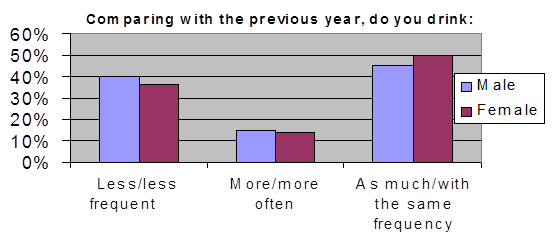Топик: Substance abuse: Alcohol Consumption and alcohol dependence among the youth (Социологическое исследование проблемы алкоголизма среди студентов)

From the graph above we can see the following interesting fact: none of the women do not care about the presence of the their boyfriends while they are drinking and male respondents do not take their parents into consideration deciding haw many drinks to have.
Here we can see the tendency of male students usually drinking beer or strong alcoholic drinks, and females usually drinking cocktails of aperitifs.
The question concerned ever trying to give up drinking and never following though was aimed to reveal one of the symptoms of the first stage of alcohol dependency. The results were: 30% of men and 14 % of women tried to do so. 25% of men and no females tried to reduce the amount of alcohol consumed and succeeded and 5% and 7% respectively tried but did not succeed in reducing it.

Only 30% of males and 7% of the females would reduce the amount consumed if their parents were stricter about their behaviour. But if they cease to give them pocket money 40% of male respondents and 43% of female respondents would do it.

Only 20% of men and 14% of women consider their study success to be dependent from the results shown on the graph above.
50% of males and 36% of females wrote, that they drink to raise their mood; 20% and 10%- to support the company; 15% and 20%- to remove the stress; 15% and 34%- to celebrate some holiday respectively.
Almost 80% of males and 21% of females said that there don’t care what others (not those, whom they are aquatinted with and if they were nit policemen) would think if they saw them drunken. The answers to the question “Have you ever had extrinsic behavioural manifestations (aggressiveness/depression) connected with the consumption of alcohol?” are 35% of male respondents and 14% of female said “yes” and 65% and 86%- “no”. 40% of males and 14% of 
females have already got aquatinted with blackouts.

From my point of view, these results are much like the real ones, as I am also a student and I am doing the overt observation of all this every day. The situation seems to be catastrophic, and something should be done about it.
Literature used.
1. Britannica encyclopaedia ’99.
2. Socis magazine № 5,3,8 1997 ; № 10 1998
3. http://search1.healthgate.com/hid/alcoholism/